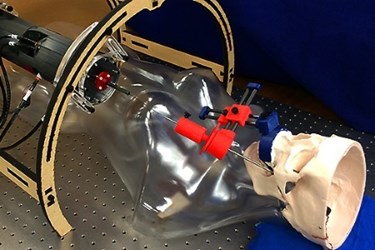Robotic Brain Surgery, Through The Cheek
By Chuck Seegert, Ph.D.

Some of the most successful robotic surgeries are the ones that take a high-risk, conventional surgery and turn it into a minimally invasive procedure. Vanderbilt University engineers have now done this for deep brain epileptic surgery using new equipment.
Epileptic seizures originate in the hippocampus, a deep-seated region of the brain that is difficult to access by conventional means. For the most severe cases, surgery must be performed on the hippocampus through a long procedure that has many risks. Additionally, recovery times can be extensive, leading to disruption of the patient’s life.
“The systems we have now that let us introduce probes into the brain – they deal with straight lines and are only manually guided,” Joseph Neimat, a professor of neurological surgery, said in a recent Vanderbilt University press release. “To have a system with a curved needle and unlimited access would make surgeries minimally invasive. We could do a dramatic surgery with nothing more than a needle stick to the cheek.”
The newly developed system uses a nickel-titanium (NiTi) alloy needle that can be guided into the brain. The NiTi needle operates like a mechanical pencil, and it uses concentric tubes that enable the needle to follow curved paths to the brain. Additionally, it is compatible with MRI systems, which allows the needle to be guided by a machine while MRI imaging takes place.
Discussion between two Vanderbilt professors led to a desire to identify a use for their nascent system.
“I’ve done a lot of work in my career on the control of pneumatic systems,” said Eric Barth, an associate professor of mechanical engineering, in the press release. “We knew we had this ability to have a robot in the MRI scanner, doing something in a way that other robots could not. Then we thought, ‘What can we do that would have the highest impact?’”
In consultation with Neimat, the team set out to develop a minimally invasive way to approach the hippocampus. The steerable needles are so versatile that they allowed the team to find approaches into the brain that pass through the cheek and access the tissue from below. The accuracy of the system was tested in the lab and shown to be within 1.18 mm of the desired location, which is suitable for an epileptic surgery, according to the press release. As a further safety check, the needle only advances 1 mm at a time with MRI scans performed with each forward motion.
The robot itself was constructed largely of 3D printed parts, and the technique was unveiled at the recent Fluid Power Innovation and Research Conference in Nashville. The team plans to begin testing in a cadaver environment as their next step.
Substituting robotic methods for highly invasive forms of open surgery has also been shown to be successful in prostate treatment, although shifting to a robotic approach should be undertaken with caution. Additive manufacturing and 3D printing methods have also become very popular in the medical device space due to their versatility and have even been cleared by the FDA for implant systems.
Image Credit: Laboratory for the Design and Control of Energetic Systems / Vanderbilt
